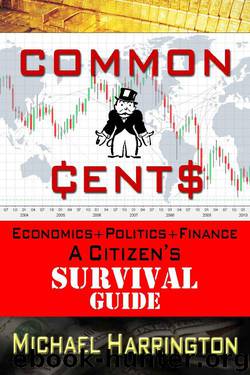Common Cents by Michael Harrington

Author:Michael Harrington [Harrington, Michael]
Language: eng
Format: epub
Publisher: RSBS Productions
Published: 2011-08-14T21:00:00+00:00
4.2 The Policy Agenda
At this point one might be tempted to ask, incredulously, what were the so-called policy experts thinking?! As we discussed earlier, our leaders focus primarily on economic growth and employment as solutions to every problem. So they seek every way to stoke the engine of GDP growth with the tools they have—loose credit promoted by Federal Reserve policy, government spending authorized by Congress, and tax cuts. But, to reiterate, we cannot borrow and spend our way to prosperity. Instead, we must invest our scarce resources efficiently and profitably. One does not need an economics degree to understand this (apparently, having one doesn't necessarily mean one understands it either). As policy critics, we can be generous and concede that to err is human. We do, however, need a way to correct our errors before they become catastrophic. And we need to learn from our mistakes. Though the rescue of the financial system from the crisis of 2008 was necessary, the danger is that we may not have learned the prudent policy lessons from this disaster.
Let us step back and use our model to think about how the economy departs from, and then returns, to equilibrium. We humans make mistakes: we open restaurants that fail in short order; we open boutiques for pets that fizzle; our investment ideas are not always brilliant. But what happens if the financiers of our bad ideas keep giving us more credit? A deep hole becomes a chasm that can swallow us whole. It is the same case with loose credit subsidized by the entire banking system. The situation only worsens when bad ideas that fail get bailed out just so they can fail again, but even bigger, another day. This is merely postponing the day of reckoning.
The super credit cycle that we experienced from 1982 to 2008 has distorted many prices and induced many inefficiencies across the economy. A price crash, or a recession, is the market's way of realigning prices to where goods once again become attractive for an exchange between buyers and sellers. When our economic policies cause, or allow, the economy to outrace itself at a rate that is unsustainable, eventually the prices of financial assets, as well as real assets, collapse as the economy contracts. After a bubble, stock prices, housing prices, energy prices, and retail goods prices all collapse. As wage rates fall, labor must be reallocated to more productive uses, which entails unemployment. When the dust settles, we pick ourselves up off the floor and rebuild.
Of course, a good policy agenda would insure that price distortions never percolate into a bubble. Once the pot has begun to boil, however, the quickest remedy is a price reset.[49] The architects of our recent economic policies have done their best to resist an asset price reset, in the hopes that we can draw out the adjustment process over time without a complete financial market failure. This strategy is prudent policy management given that the financial system was broken, but the
Download
This site does not store any files on its server. We only index and link to content provided by other sites. Please contact the content providers to delete copyright contents if any and email us, we'll remove relevant links or contents immediately.
The Secret History by Donna Tartt(16623)
The Social Justice Warrior Handbook by Lisa De Pasquale(11489)
Thirteen Reasons Why by Jay Asher(7788)
This Is How You Lose Her by Junot Diaz(5772)
Weapons of Math Destruction by Cathy O'Neil(5037)
Zero to One by Peter Thiel(4824)
The Myth of the Strong Leader by Archie Brown(4789)
Promise Me, Dad by Joe Biden(4447)
Beartown by Fredrik Backman(4419)
Stone's Rules by Roger Stone(4415)
How Democracies Die by Steven Levitsky & Daniel Ziblatt(4399)
The Fire Next Time by James Baldwin(4343)
100 Deadly Skills by Clint Emerson(4079)
A Higher Loyalty: Truth, Lies, and Leadership by James Comey(4033)
Rise and Kill First by Ronen Bergman(4012)
The David Icke Guide to the Global Conspiracy (and how to end it) by David Icke(3882)
The Farm by Tom Rob Smith(3872)
Secrecy World by Jake Bernstein(3782)
The Doomsday Machine by Daniel Ellsberg(3731)
